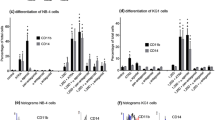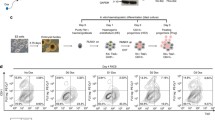Abstract
Background
The retinoblastoma-interacting zinc-finger gene RIZ is expressed in two forms (RIZ1 and RIZ2) that differ for the presence near the N-terminus of RIZ1 of a conserved domain, defined PR (PRDI-BF1-RIZ homology), homologous to a similar domain present in other proteins recognized as tumor suppressor gene products. The RIZ1 form is usually absent or expressed at low levels in tumor cells, whereas RIZ2 is frequently expressed. We investigated a possible involvement of RIZ1 in differentiation control using a myeloid cell maturation model that is easily modulated by retinoids and other agents.
Materials and Methods
HL60 or NB4 cell lines or patients’ leukemic promyelocytes were treated with all-trans-retinoic acid or other agents to induce differentiation. RIZ gene expression was determined with reverse transcriptase polymerase chain reaction (RT-PCR) and RNase protection assay. Immunocytochemistry was performed to assess variation of the intracellular distribution of RIZ protein on all-trans-retinoic acid treatment. Forced expression of RIZ1 protein was obtained with a recombinant adenovirus containing RIZ1 cDNA.
Results
Treatment with retinoic acid induced a selective expression of RIZ1 in HL60 cell line. Retinoic acid effect was maximal at 7 days and correlated to the granulocytic differentiation of cells. A similar effect was obtained in retinoic acid-sensitive NB4 cell line or in patients’ leukemic promyelocytes, but not in the retinoic acid-resistant cell line NB4.007/6 or in the U937 cell line. Selective expression of RIZ1 was also induced by 12-O-tetradecanoyl-phorbol-13-acetate in the U937 and HL60 cell lines and by 1,25-dihydroxyvitamin D3 only in HL60 cells. In HL60 cells, RIZ1 was also induced by activation of a retinoid α receptor-independent maturation pathway based on retinoid X receptor agonist and protein kinase A synergism. In addition, retinoic acid produced a redistribution of the antigen within the nucleus in these cells. Forced expression of RIZ1 protein induced growth arrest and death of HL60 cells.
Conclusions
The correlation between the selective expression of RIZ1 induced by retinoic acid, 12-O-tetradecanoyl-phorbol-13-acetate, or 1,25-dihydroxyvitamin D3 and differentiation suggested that RIZ protein was involved in myeloid cell differentiation induced by these agents.





Similar content being viewed by others
References
Buyse IM, Shao G, Huang S. (1995) The retinoblastoma protein binds to RIZ, a zinc-finger protein that shares an epitope with the adenovirus E1A protein. Proc. Natl. Acad. Sci. U.S.A. 92: 4467–4471.
Muraosa Y, Takahashi K, Yoshizawa M, Shibahara S. (1996) cDNA cloning of a novel protein containing two zinc-finger domains that may function as a transcription factor for the human heme-oxygenase-1 gene. Eur. J. Biochem. 235: 471–479.
Xie M, Shao G, Buyse I, Huang S. (1997) Transcriptional repression mediated by the PR domain zinc finger gene RIZ. J. Biol. Chem. 272: 26360–26366.
Shapiro VS, Lee P, Winoto A. (1995) Identification and cloning of the G3B cDNA encoding a 3′ segment of a protein binding to GATA-3. Gene 163: 329–330.
Buyse IM, Takahashi EI, Huang S. (1996) Physical mapping of the retinoblastoma interacting zinc finger gene RIZ to D1S228 on chromosome 1p36. Genomics 34: 119–121.
Chadwick RB, Jiang GL, Bennington GA, et al. (2000) Candidate tumor suppressor RIZ is frequently involved in colorectal carcinogenesis. Proc. Natl. Acad. Sci. U.S.A. 97: 2662–2667.
Liu L, Shao G, Steele-Perkins G, Huang S. (1997) The retinoblastoma interacting zinc finger gene RIZ produces a PR domain-lacking product through an internal promoter. J. Biol. Chem. 272: 2984–2991.
Fears S, Vignon C, Bohlander SK, Smith S, Rowley JD, Nucifora G. (1996) Intergenic splicing of MDS1 and EVI1 occurs in normal tissues as well as in myeloid leukemia and produces a new member of the PR domain family. Proc. Natl. Acad. Sci. U.S.A. 93: 1642–1647.
Turner CAJ, Mack DH, Davis MM. (1994) Blimp-1, a novel zinc finger-containing protein that can drive the maturation of B lymphocytes into immunoglobulin-secreting cells. Cell 77: 297–306.
Messika EJ, Lu PS, Sung YJ, et al. (1998) Differential effect of B lymphocyte-induced maturation protein (Blimp-1) expression on cell fate during B cell development. J. Exp. Med. 188: 515–525.
Chittka A, Chao MV. (1999) Identification of a zinc finger protein whose subcellular distribution is regulated by serum and nerve growth factor. Proc. Natl. Acad. Sci. U.S.A. 96: 10705–10710.
Yang X, Huang S. (1999) PFM1 (PRDM4), a new member of the PR-domain family, maps to a tumor suppressor locus on human chromosome 12q23-q24.1. Genomics 61: 319–325.
He L, Yu JX, Liu L, et al. (1998) RIZ1, but not the alternative RIZ2 product of the same gene, is underexpressed in breast cancer, and forced RIZ1 expression causes G2-M cell cycle arrest and/or apoptosis. Cancer Res. 58: 4238–4244.
Jiang GL, Liu L, Buyse IM, Simon D, Huang S. (1999) Decreased RIZ1 expression but not RIZ2 in hepatoma and suppression of hepatoma tumorigenicity by RIZ1. Int. J. Cancer 83: 541–546.
Abbondanza C, Medici N, Nigro V, et al. (2000) The retinoblastoma-interacting zinc-finger protein RIZ is a downstream effector of estrogen action. Proc. Natl. Acad. Sci. U.S.A. 97: 3130–3135.
Grignani F, Fagioli M, Alcalay M, et al. (1994) Acute promyelocytic leukemia: from genetics to treatment. Blood 83: 10–25.
Slack JL, Gallagher RE. (1999) The molecular biology of acute promyelocytic leukemia. Cancer Treat. Res. 99: 75–124.
Breitman TR, Collins SJ, Keene BR. (1981) Terminal differentiation of human promyelocytic leukemic cells in primary culture in response to retinoic acid. Blood 57: 1000–1004.
Lo Coco F, Diverio D, Falini B, Biondi A, Nervi C, Pelicci PG. (1999) Genetic diagnosis and molecular monitoring in the management of acute promyelocytic leukemia. Blood 94: 12–22.
Fanelli M, Minucci S, Gelmetti V, Nervi C, Gambacorti-Passerini C, Pelicci PG. (1999) Constitutive degradation of PML/RARalpha through the proteasome pathway mediates retinoic acid resistance. Blood 93: 1477–1481.
Medici N, Abbondanza C, Nigro V, et al. (1999) Identification of a DNA binding protein cooperating with estrogen receptor as RIZ (retinoblastoma interacting zinc finger protein). Biochem. Biophys. Res. Commun. 264: 983–989.
Lee WS, Kao CC, Bryant GO, Liu X, Berk AJ. (1991) Adenovirus E1A activation domain binds the basic repeat in the TATA box transcription factor. Cell 67: 365–376.
Dignam JD, Lebovitz RM, Roeder RG. (1983) Accurate transcription initiation by RNA polymerase II in a soluble extract from isolated mammalian nuclei. Nucleic Acids Res. 11: 1475–1489.
Breitman T, Selonick S, Collins S. (1980) Induction of differentiation of the human promyelocytic leukemia cell line (HL-60) by retinoic acid. Proc. Natl. Acad. Sci. U.S.A. 77: 2936–2940.
Benoit G, Altucci L, Flexor M, et al. (1999) RAR-independent RXR signaling induces t(15;17) leukemia cell maturation. EMBO J. 18: 7011–7018.
Mori A, Higashi H, Hoshikawa Y, Imamura M, Asaka M, Hatakeyama M. (1999) Granulocytic differentiation of myeloid progenitor cells by p130, the retinoblastoma tumor suppressor homologue. Oncogene 18: 6209–6221.
Koeffler HP, Bar-Eli M, Territo MC. (1981) Phorbol ester effect on differentiation of human myeloid leukemia cell lines blocked at different stages of maturation. Cancer Res. 41: 919–926.
McCarthy DM, San Miguel JF, Freake HC, Green PM, Zola H, Catovsky D, Goldman JM. (1983) 1,25-dihydroxyvitamin D3 inhibits proliferation of human promyelocytic leukaemia (HL60) cells and induces monocyte-macrophage differentiation in HL60 and normal human bone marrow cells. Leuk. Res. 7: 51–55.
Lin Y, Wong K, Calame K. (1997) Repression of c-myc transcription by Blimp-1, an inducer of terminal B cell differentiation. Science 276: 596–599.
Sood R, Talwar-Trikha A, Chakrabarti SR, Nucifora G. (1999) MDS1/EVI1 enhances TGF-beta1 signaling and strengthens its growth-inhibitory effect but the leukemia-associated fusion protein AML1/MDS1/EVI1, product of the t(3;21), abrogates growth-inhibition in response to TGF-beta1. Leukemia 13: 348–357.
Acknowledgments
We thank Dr. She Huang (The Burnham Institute, La Jolla, CA, USA) for providing the AdRIZ1 and AdGFP adenovirus vectors, Dr. Mirco Fanelli (Istituto Europeo di Oncologia, Milano, Italy) for the NB4.007/6 cell line, and Dr. Saverio Minucci (Istituto Europeo di Oncologia, Milano, Italy) for helpful discussions.
This investigation was supported by the Italian Ministry for University and Scientific and Technological Research.
Author information
Authors and Affiliations
Corresponding author
Additional information
P. G. and P. B. equally contributed to the work.
Rights and permissions
About this article
Cite this article
Gazzerro, P., Bontempo, P., Schiavone, E.M. et al. Differentiation of Myeloid Cell Lines Correlates with a Selective Expression of RIZ Protein. Mol Med 7, 552–560 (2001). https://doi.org/10.1007/BF03401861
Accepted:
Published:
Issue Date:
DOI: https://doi.org/10.1007/BF03401861




